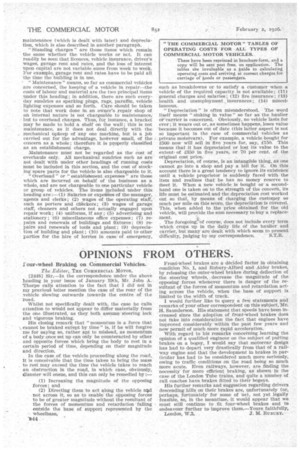OPINIONS FROM OTHERS.
Page 28

If you've noticed an error in this article please click here to report it so we can fix it.
Tour-wheel Braking on Commercial Vehicles.
The Editar, TEE COMMERCIAL MOTOR.
[2448] Sir,—In the correspondence under the above heading in your issue of January 19th, Mr. John A. Thorpe callis attention to the fact that I did not in ray previouA letter mention the case of the rear of the vehicle slewing outwards towards the centre of the road.
Whilst not specifically dealt with, the case he calls attention to would not appear to differ materially from the one illustrated, as they both assume steering lock and vigorous braking.
His closing remark that "momentum is a force that cannot be braked extept by time" is, if he will forgive me for saying so, rather apt to mislead, as momentum of a body once set up can only be counteracted by other and opposite forces which bring the body to rest in a certain period of time, depending on their magnitude and direction.
In the case of the vehicle proceeding along the road, It is conceivable that the time taken to bring the massto rest may exceed the time the vehicle takes to reach an obstruction in the road, in which case, obviously, disaster will ensue, and this can only be remedied by :—
(1) Increasing the magnitude of the opposing forces ; and (2) Directing them to act along the vehicle mid riot across it, so as to enable the opposing forces to be of greater magnitude without the resultant of the forces of momentum and retardation falling outside the base of support represented by the wheelbase.
'B44 Front-wheel brakes are a decided factor in obtaining condition No. 1, and Rubury-Alford and Alder brakes, by releasing the outer-wheel brakes during deflection of the steering wheels, decrease the magnitude of the opposing forces whenever there is danger of the resultant of the forces of momentum and retardation acting across the vehicle, when the base of support is limited to the width of track.
I would further like to query a few statements and remarks of your other correspondent on this subject, Mr. H. Saunderson. His statement that speeds have been increased since the adoption of front-wheel brakes does not take into consideration the fact that engines have improved considerably within the past few years and now permit of Inueli more rapid acceleration.
With regard to his remarks concerning learning the opinion of a qualified engineer on the subject of putting brakes on a bogey, I would say that motorcar design has had to depart very drastically from that of a railway engine and that the development in brakes in particular has had to be considered much more seriously, owing to traffic conditions on the road being so much more acute. Even railways, however, are finding the necessity for more efficient braking, as shown in the case of the London Tube trains, and quite a number of rail coaches have brakes fitted to their bogeys.
His further remarks and suggestion regarding drivers descending hills on their brakes are, unfortunately (or, perhaps, fortunately for some of us), not yet legally feasible, So, in the meantime, it would appear that we must still continue to fit four-wheel brakes and to endeavour further to improve them—Yours faithfully, London, W.3. J. M. RUBURY.






























